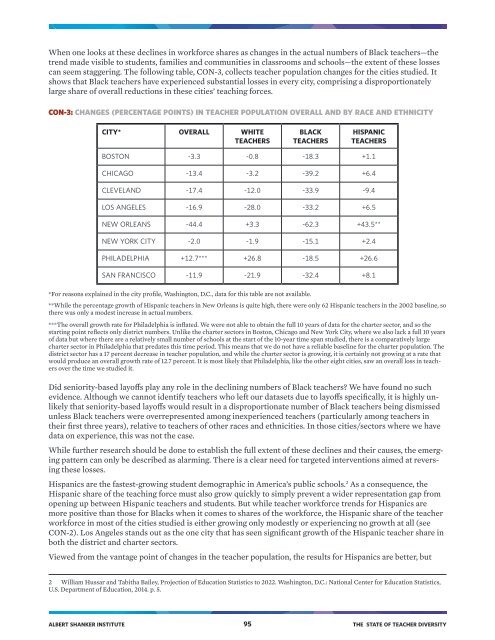TEACHER DIVERSITY
The State of Teacher Diversity_0
The State of Teacher Diversity_0
- No tags were found...
Create successful ePaper yourself
Turn your PDF publications into a flip-book with our unique Google optimized e-Paper software.
When one looks at these declines in workforce shares as changes in the actual numbers of Black teachers—the<br />
trend made visible to students, families and communities in classrooms and schools—the extent of these losses<br />
can seem staggering. The following table, CON-3, collects teacher population changes for the cities studied. It<br />
shows that Black teachers have experienced substantial losses in every city, comprising a disproportionately<br />
large share of overall reductions in these cities’ teaching forces.<br />
CON-3: CHANGES (PERCENTAGE POINTS) IN <strong>TEACHER</strong> POPULATION OVERALL AND BY RACE AND ETHNICITY<br />
CITY* OVERALL WHITE<br />
<strong>TEACHER</strong>S<br />
BLACK<br />
<strong>TEACHER</strong>S<br />
HISPANIC<br />
<strong>TEACHER</strong>S<br />
BOSTON -3.3 -0.8 -18.3 +1.1<br />
CHICAGO -13.4 -3.2 -39.2 +6.4<br />
CLEVELAND -17.4 -12.0 -33.9 -9.4<br />
LOS ANGELES -16.9 -28.0 -33.2 +6.5<br />
NEW ORLEANS -44.4 +3.3 -62.3 +43.5**<br />
NEW YORK CITY -2.0 -1.9 -15.1 +2.4<br />
PHILADELPHIA +12.7*** +26.8 -18.5 +26.6<br />
SAN FRANCISCO -11.9 -21.9 -32.4 +8.1<br />
*For reasons explained in the city profile, Washington, D.C., data for this table are not available.<br />
**While the percentage growth of Hispanic teachers in New Orleans is quite high, there were only 62 Hispanic teachers in the 2002 baseline, so<br />
there was only a modest increase in actual numbers.<br />
***The overall growth rate for Philadelphia is inflated. We were not able to obtain the full 10 years of data for the charter sector, and so the<br />
starting point reflects only district numbers. Unlike the charter sectors in Boston, Chicago and New York City, where we also lack a full 10 years<br />
of data but where there are a relatively small number of schools at the start of the 10-year time span studied, there is a comparatively large<br />
charter sector in Philadelphia that predates this time period. This means that we do not have a reliable baseline for the charter population. The<br />
district sector has a 17 percent decrease in teacher population, and while the charter sector is growing, it is certainly not growing at a rate that<br />
would produce an overall growth rate of 12.7 percent. It is most likely that Philadelphia, like the other eight cities, saw an overall loss in teachers<br />
over the time we studied it.<br />
Did seniority-based layoffs play any role in the declining numbers of Black teachers? We have found no such<br />
evidence. Although we cannot identify teachers who left our datasets due to layoffs specifically, it is highly unlikely<br />
that seniority-based layoffs would result in a disproportionate number of Black teachers being dismissed<br />
unless Black teachers were overrepresented among inexperienced teachers (particularly among teachers in<br />
their first three years), relative to teachers of other races and ethnicities. In those cities/sectors where we have<br />
data on experience, this was not the case.<br />
While further research should be done to establish the full extent of these declines and their causes, the emerging<br />
pattern can only be described as alarming. There is a clear need for targeted interventions aimed at reversing<br />
these losses.<br />
Hispanics are the fastest-growing student demographic in America’s public schools. 2 As a consequence, the<br />
Hispanic share of the teaching force must also grow quickly to simply prevent a wider representation gap from<br />
opening up between Hispanic teachers and students. But while teacher workforce trends for Hispanics are<br />
more positive than those for Blacks when it comes to shares of the workforce, the Hispanic share of the teacher<br />
workforce in most of the cities studied is either growing only modestly or experiencing no growth at all (see<br />
CON-2). Los Angeles stands out as the one city that has seen significant growth of the Hispanic teacher share in<br />
both the district and charter sectors.<br />
Viewed from the vantage point of changes in the teacher population, the results for Hispanics are better, but<br />
2 William Hussar and Tabitha Bailey, Projection of Education Statistics to 2022. Washington, D.C.: National Center for Education Statistics,<br />
U.S. Department of Education, 2014. p. 5.<br />
ALBERT SHANKER INSTITUTE 95 THE STATE OF <strong>TEACHER</strong> <strong>DIVERSITY</strong>


